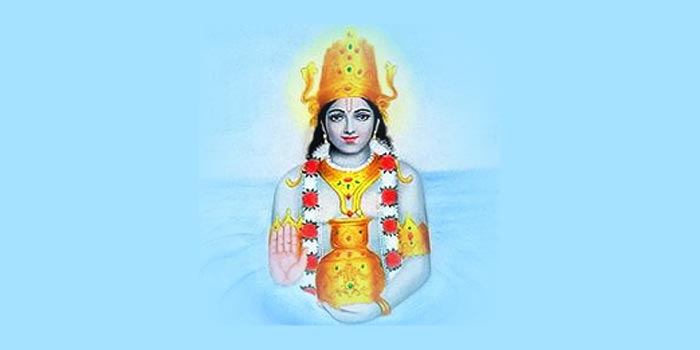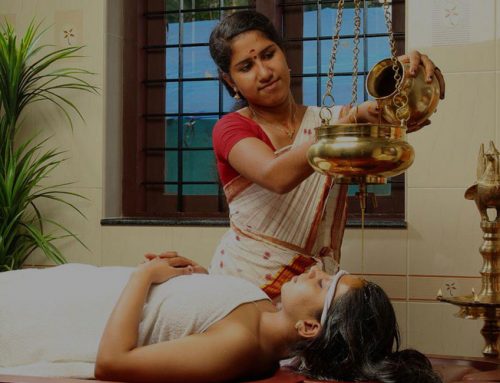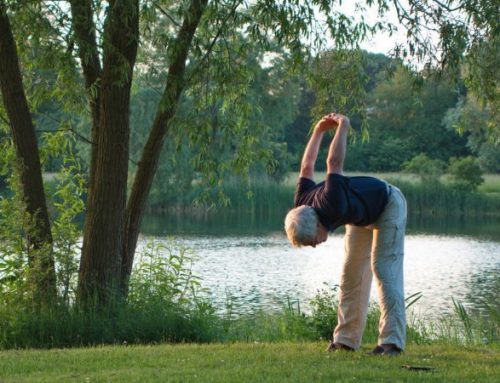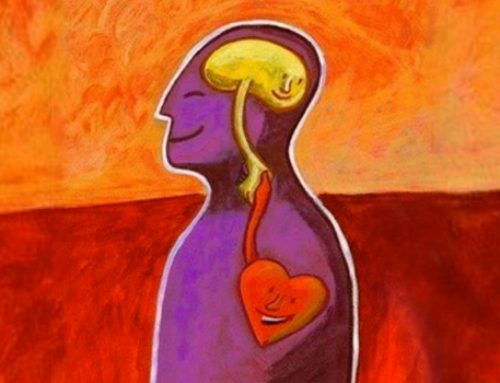Written by Andrea Olivera
A Vedic creation myth begins with the Ocean of Consciousness occupied by Gods and Asuras or demons. They both desired immortality and with this common goal, they together churned the Ocean of Consciousness creating a rich foam from which sprang many wonderful things including Dhanvantari, the father of Ayurveda, who brought with him the Amrita, the water of life, or ‘nectar of immortality’.
![]()
But, before the Gods could fully grasp this Amrita, Rahu (an Asura) stole it and tasted it before Vishnu cut him in two with his avenging sword. The Gods regained the Amrita but Rahu along with its severed tail, Ketu, attained immortality as the north and south nodes of the Moon. Rahu, the north node, in particular represents insatiable urges in the birth chart. The nodes are what eclipse the Sun (soul) and Moon (mind).
![]()
The Amrita is the essence of what are called Rasayanas, Ayurveda rejuvenation therapies aimed at restoring the body’s natural fluidity, both physically and spiritually. Rasayana means ‘the way of the elixir’ and is akin to the Philosopher’s Stone and the philosophy of immortality. In Ayurveda it is rejuvenating the vital fluids of the body. Rasa is the essence or bliss of something as a state of surrender to the Divine. Rasayanas prevent constriction, illness and aging by restoring fluidity to the body and consciousness. When spirit loses its flow, illness is not to far away.
![]()
The Gods signify our higher selves, willing to serve, knowing Grace, while the Asuras represent our lower, physical selves or ego; that part of us that wants to be served; that will even steal to gratify itself. It is this balancing act that Ayurveda on the whole addresses.
![]()
Ayurveda is a system of holistic medicine that diagnoses and treats illness or dis-ease in the body using essentially three doshas or elements: Vata (Air/Ether), Pitta (Fire/Water) and Kapha (Earth/Water). Dis-ease is diagnosed as either predominance or lacking in one of these doshas and the aim is to regain balance through restorative measures using diet, exercise, massage, yoga, herbs, oils and scents.
![]()
Being a holistic science, Ayurveda is a preventative. It uses the big picture approach of Jyotish (Vedic astrology) to examine our karmic map. Rahu’s role in the creation myth characterizes our irrational obsessions and ambitions. In the client’s astrological chart, it reveals where these insatiable urges lie; what they are obsessed with or addicted to. For some it is fame, for others, sex or family or money. Indeed, it reveals what could be killing us.
![]()
Astrology compliments Ayurveda in this way. What is not always obvious to the Ayurveda practitioner addressing physical symptoms is the underlying karmic cause of these symptoms. A Jyotishi (astrologer) or someone knowledgeable of Jyotish can usually spot it at a glance. Further analysis can also determine what part of the client’s karma is active at a given time. This information is useful in counselling the client as core issues are often what obstruct the rejuvenating process. Addressing them may bring rebirth.
![]()
Yoga is an excellent resource for physical and mental exercises that help facilitate Rasayanas. Yoga cultivates discipline and awareness as one works towards physical and spiritual fluidity through relaxation techniques that can ultimately lead to self-realization and spiritual bliss. Yoga is a form of alchemy and its aim is to transmute human consciousness. In this age of atheism, yoga is the new religion because it applies consciousness in a practical, humanistic way towards a definite aim and without dogma. And like Ayurveda, Yoga is customizable.
![]()
The popularity of Yoga world-wide has increased interest in Ayurveda and holistic living in general including astrological remedies. These various disciplines are being integrated more and more into the programs of spa and yoga centres around the world. People are understanding again that health and beauty begin with our relationship to Nature and this includes ourselves, how we eat, what we think, what we can smell, whether we are polluting or renewing.
![]()
The Ocean of Consciousness is forever being churned. This is the fundamental friction of our lives, between service and selfishness or fluidity and constriction. Rasayanas are there to restore the fluidity, the Godliness in us, and to do so holistically.
![]()
Ayurveda’s great strength is its ability to draw on disciplines like Jyotish and Yoga for a multi-layered approach. Rasayanas replenish and rejuvenate in part through us developing our understanding of our own unique constitution, what to eat, where to live, who to look for… When we are in harmony, then flow is assured and obstacles are averted. It becomes obvious then that in this Ocean of Consciousness, fluidity is our path to liberation.







